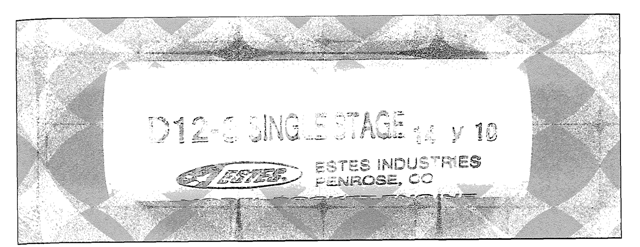When working with rocket motors, you need a way of ranking them according to their performance. This topic uses the system developed by the model rocket industry in the 1960s. It was originally intended for motors up through D. but the makers of high power rocket motors now use it too. It arranges motors according to their total impulse, their average thrust, and the time delay before parachute ejection. In the English system, rocket thrust is measured in pounds, but this system is metric, so the thrust is measured in “Newtons”. The metric-to-English conversion ratio is 4.45 Newtons per pound, so one Newton equals 0.225 pound.
Figure 2-18 shows a commercially manufactured model rocket motor of the type sold in hobby shops. This one is made by Estes Industries of Penrose. Colorado, and it’s classified according to the system described above. Notice the letter-number code stamped directly above the company logo. It says “D12-3″.
A few pages ago I defined “total impulse”. The letter. D. refers to this value, and indicates that it lies somewhere between 10.01 and 20.00 Newton-seconds (abbreviated “Nt.-secs.”). The number. 12. after the letter. D. is the average thrust of the motor in Newtons. 12 Nev\tons in the metric system equals about 2.7 lbs. in the English system, so the motor’s average thrust is 2.7 lbs. Most commercial model rocket motors use a small, pyrotechnic charge to push out the rocket’s parachute. The final number in the triad (a 3 in this case) is the time delay in seconds between the end of the motor’s burn and the moment of parachute ejection. A 0 (that’s a zero) means that there is no delay, and that the motor is a booster. A P means that there is no delay, and that the front of the motor is completely plugged. A plugged motor does not function as a booster, and will not eject a parachute. Plugged motors are used in rocket powered gliders, or rockets with clusters of motors, where one of the other motors contains the charge needed to fire the second stage or eject the parachute.

Figure 2-18. A commercially manufactured Estes D12 model rocket motor (shown larger than actual size). The letter-number code printed on the side indicates the total impulse, the average thrust, and the time delay (in seconds J before parachute ejection.
I’ve illustrated the entire classification system in Figure 2-19 on page 36. and I’ve calculated the total impulse ranges in the English and metric systems. As you can see. each time you go up a letter in the alphabet, the motor’s total impulse range doubles. For rocket motors using the same propellant. the total propellant weight doubles as well. I’ve taken it as for as the J classification, but as of this writing, motors as large as P have been successfully built and flown.
Of course the letter classification for total impulse provides only a range, and doesn’t give an exact figure. In the example of the Estes motor the question arises as to whether the total impulse is 10.01 Nt.-secs.. 20.00 Nt.-secs.. or something in between. In 1991 Fred Brennion of Rogers’ Aeroscience adopted a logical solution to the problem by placing the number for the motor’s total impulse (in Nt.-secs.) in front of the letter designation.
Since the Estes motor has a total impulse of 19.60 Nt.-secs.. Fred would round that number off to 19. and relabel the motor a 19-D12-3. Rogers’ Aeroscience now uses this labeling method in their rocket performance prediction programs, and the practice is gradually being adopted by other people in the industry.
For my own work, because the type of propellant is important. I give each propellant a letter-number classification, and place “that figure in front of all the others. If the motor in this example happened to run on the KG3 propellant. it would be a KG3-19-D12-6. But because the motors in this topic are all homemade, and you can make the time delays any length you wish. I’d drop the number for the time delay, and call the motor a KG3-19-D12.

Figure 2-19. The rocket motor classification system used by the commercial model rocket and high power rocket industries. Each new letter in the alphabet doubles the size of the previous motor. This chart shows total impulse ranges up through J. but the system can be extended indefinitely.
Motor Classification (Rocket Motor)
Next post: TOOLS YOU BUY (Rocket Motor)
Previous post: Single Stage Rockets (Rocket Motor)
